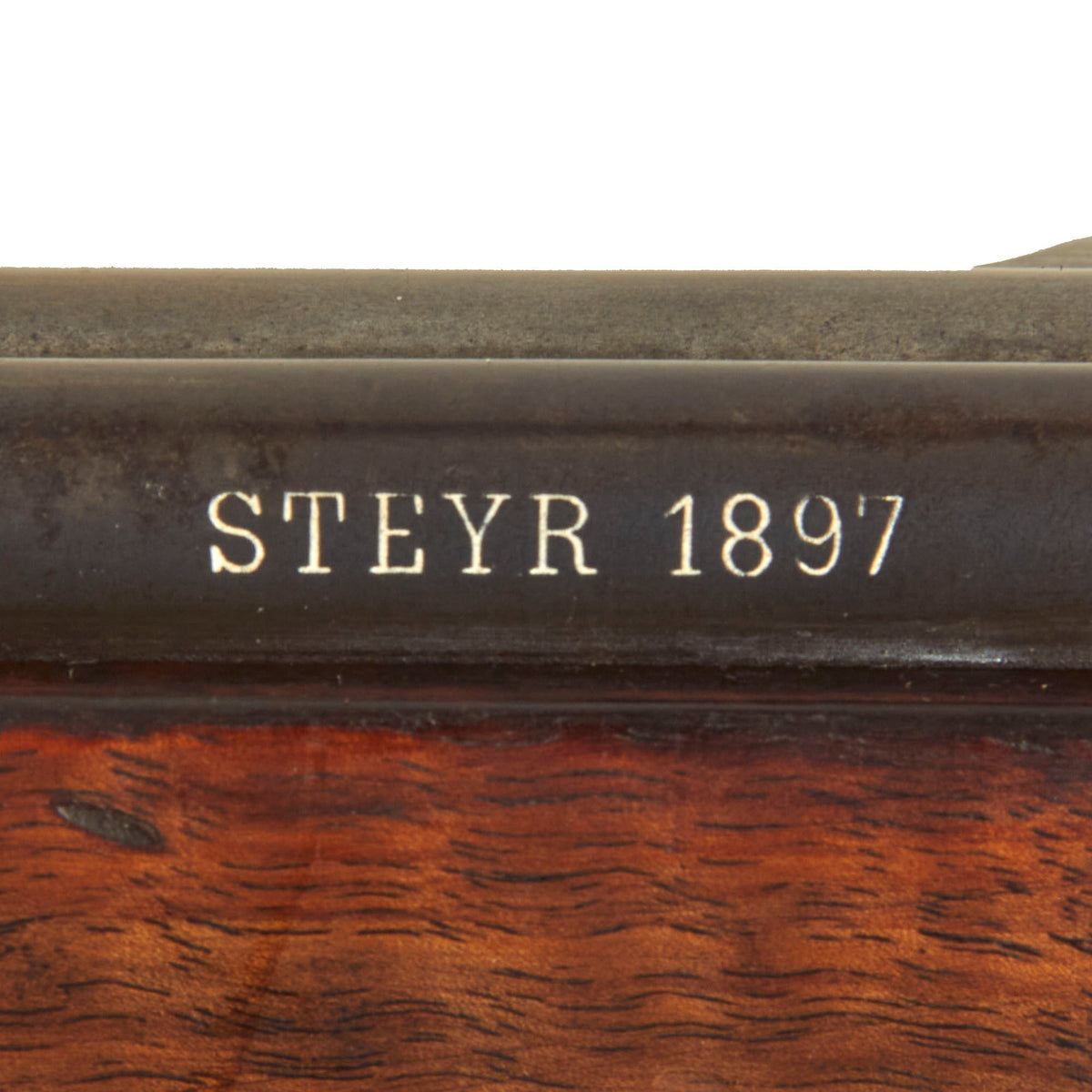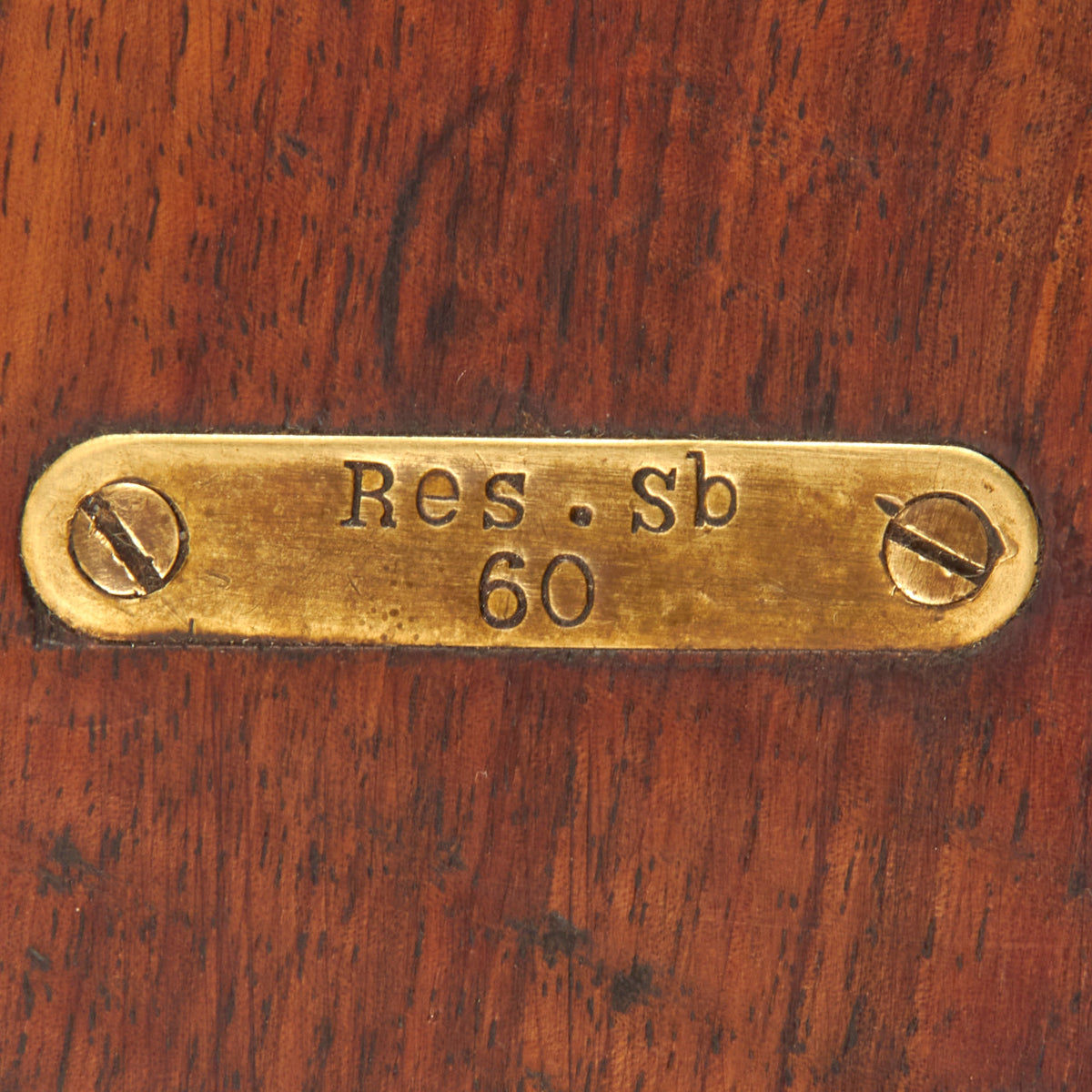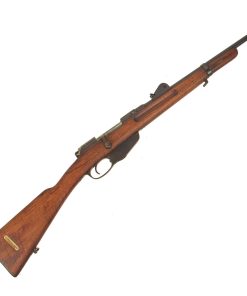Original Dutch Pre-WWI Karabijn M. 95 Mannlicher KNIL Colonial Constabulary Carbine by ŒWG Steyr Serial 3560D – Dated 1897 Original Items
$ 1.495,00 $ 373,75
Original Item: Only one Available. This is a lovely example of the rare Dutch Karabijn M. 95 Mannlicher, used by the Royal Netherlands East Indies Army (Koninklijk Nederlands Indisch Leger or KNIL). While these were taken out of service after WWII in the Netherlands, in the colonies they were still being used until at least 1955. This colonial army utilized 4 different variations of the carbine, and this is the Colonial Constabulary Carbine for Military Police, which was very similar to the Cavalry Carbine, differing only in sling swivel placement. The cavalry carbine put the bent steel “T” shaped sling swivels on the left side of the stock, while on the Constabulary Carbine they are on the bottom. Both feature a rounded front of the stock, with no provision for a ramrod. Unlike the Rifles, these carbines were exclusive to KNIL service.
This rifle was manufactured by the Steyr Mannlicher firearms division of Österreichische Waffenfabriksgesellschaft (ŒWG, Austrian Arms-Manufacturing Company) in Austria. The right side of the receiver is simply marked STEYR 1897, with no other markings present on the receiver except for some proofs. The end of the barrel is however marked with serial number 3560D with 3560 on the bolt. and the magazine, rear sight, barrel band, and other components are marked with shortened number 60 or 60C. It also has 1938 on the barrel below the sight, but we do no know if this is a date or just an issue number. While production on these rifles at Steyr had long ceased by then, the rifles continued to be refurbished at arsenal long after production.
The carbine is in very good to excellent condition, we assume due to an arsenal reconditioning in the late 1930s. The blued finish on the metalwork is very well retained, and there is no rust or other issues we can see, just some light wear. The markings are crisp and have been highlighted in white to make them easier to see. The stock is in great shape, with a lovely finish, and is made of beautiful “tiger flame” figured wood. which has some real depth to it. There is no top handguard, correct for this model of carbine, and it has a brass unit plaque on the right butt stock, which reads Res . Sb / 60.
The rifle cycles and dry fires correctly, with an intact firing pin and extractor present on the bolt. The bore is in very good condition, showing strong lands and grooves with a bright finish. There is some light wear to the lands, so it definitely did see some level of service.
A great example of a Rare Dutch colonial service carbine that most likely saw long service, probably up through WWII. Fully cleaned and ready to display!
Specifications:-
Year of Manufacture: 1897
Caliber: 6.5×53mmR
Cartridge Type: Centerfire Cartridge
Barrel Length: 17 1/2 Inches
Overall Length: 37 3/8 Inches
Action type: Bolt-Action
Feed System: 5 round internal magazine with En-Bloc clip
History of the Dutch Mannlicher
The Geweer M. 95, also known to collectors as the Dutch Mannlicher, was the service rifle of the Armed forces of the Netherlands between 1895 and 1940 which replaced the obsolete Beaumont-Vitali M1871/88. At first it was produced by Steyr for the Dutch, but after 1904, production took place under license at Hembrug Zaandam in the Netherlands. Although often regarded as being based on the earlier Mannlicher 1893 Model, the rifle is in fact a modification of the Mannlicher rifle by August Schriever and the Dutch rifle commission[2]. The Dutch issued about 470,000 M.95s.
Both Dutch and Romanian rifles fired the same rimmed cartridge often referred to as “Romanian” 6.5×53.5mmR or “Dutch 6.5” 6.5×53 mmR. In military service, Dutch M.95 rifles (6.5×53 mmR) cartridges are loaded primarily through the use of an en-bloc clip, similar in concept to the clip used later by the US Army’s M1 Garand. With the Ferdinand Mannlicher designed trigger guard / magazine housing assembly, when the bolt is open and fully retracted to the rear the full en-bloc clip is loaded into the magazine from the top through the open receiver. The empty clip will fall out through a hole in the base of the magazine housing when out of cartridges. This enabled quick reloading of the rifles during combat. When the bolt is in the fully open and retracted position, full clips can be vigorously ejected upwards from the magazine housing by means of a spring loaded latch at the rear of the magazine. This is operated by a recessed button in the front of the trigger guard portion of the assembly. The clips were essentially disposable as ammunition would be issued already loaded into clips from the factory.
Fast Shipping with Professional Packaging
Thanks to our longstanding association with UPS FedEx DHL, and other major international carriers, we are able to provide a range of shipping options. Our warehouse staff is expertly trained and will wrap your products according to our exact and precise specifications. Prior to shipping, your goods will be thoroughly examined and securely secured. We ship to thousands clients each day across multiple countries. This shows how we're dedicated to be the largest retailer on the internet. Warehouses and distribution centres can be located throughout Europe as well as the USA.
Note: Orders with more than one item will be assigned a processing date depending on the item.
Before shipping before shipping, we'll conduct a thorough inspection of the items you have ordered. Today, the majority of orders will be delivered within 48 hours. The delivery time will be between 3-7 days.
Returns
The stock is dynamic and we cannot completely manage it because multiple stakeholders are involved, including our factory and warehouse. So the actual stock may alter at any time. It's possible that you may not receive your order once the order has been made.
Our policy is valid for a period of 30 days. If you don't receive the product within 30 days, we are not able to issue a refund or an exchange.
You can only return an item if it is unused and in the same state as the day you received it. You must have the item in its original packaging.
Related products
Uncategorized
Uncategorized
Uncategorized
Uncategorized
Uncategorized
Uncategorized
Uncategorized
Uncategorized
Uncategorized
Uncategorized
Uncategorized
Uncategorized
Band of Brothers ORIGINAL GERMAN WWII Le. F.H. 18 10.5cm ARTILLERY PIECE Original Items
Uncategorized
Uncategorized
Uncategorized
Armored Burgonet Helmet & Polearm from Scottish Castle Leith Hall Circa 1700 Original Items













































































